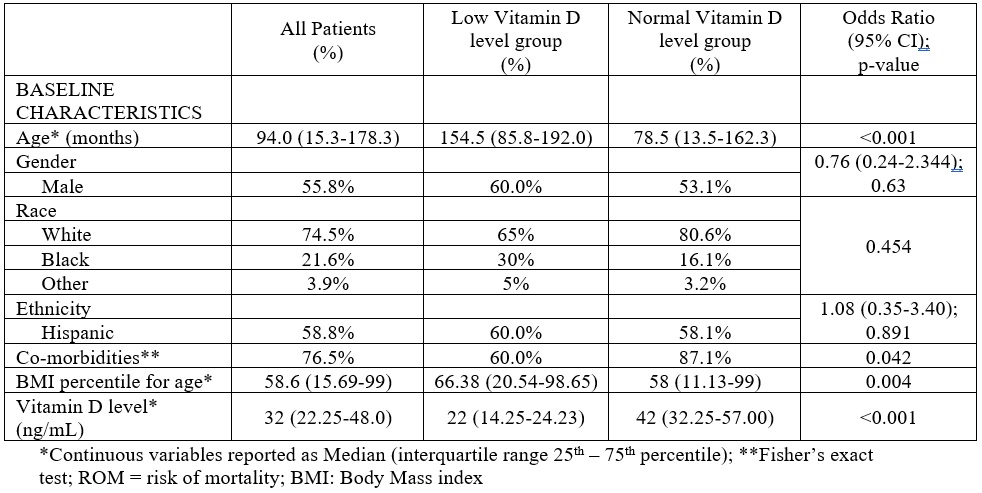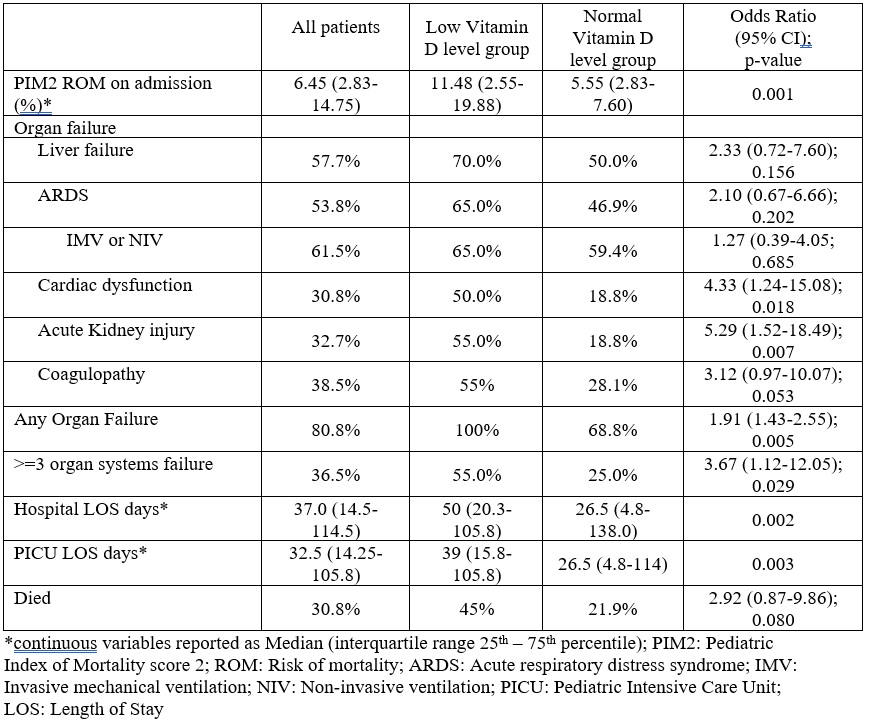Pediatric Nutrition
Category: Abstract Submission
Pediatric Nutrition I
258 - Vitamin D levels and outcomes in critically ill children
Friday, April 22, 2022
6:15 PM - 8:45 PM US MT
Poster Number: 258
Publication Number: 258.141
Publication Number: 258.141
Adriana Rodriguez Gonzalez, UPMC Childrens Hospital of Pittsburgh, Pittsburgh, PA, United States; Christy N. Gardner, Nicklaus Children’s Hospital, Miami Beach, FL, United States; Meghana Nadiger, University of Illinois College of Medicine, Dunlap, IL, United States; Balagangadhar R. Totapally, Nicklaus Children’s Hospital, Miami, FL, United States

Adriana Rodriguez Gonzalez, MD
Fellow
UPMC Childrens Hospital of Pittsburgh
Pittsburgh, Pennsylvania, United States
Presenting Author(s)
Background: The prevalence of low levels of vitamin D levels in critically ill children varies and the studies have shown inconsistent results regarding the effects of low vitamin D levels on ICU outcomes.
Objective: To describe the clinical characteristics, the prevalence, and the outcomes of critically ill children with low vitamin D levels.
Design/Methods: IIn a retrospective study, after IRB approval we reviewed charts of critically ill patients aged 1 month to < 21 years of age, admitted to the PICU over a two-and-half-year period in whom vitamin D level was measured. Vitamin D level < 30 ng/ml was considered low. Children with low and normal vitamin D levels were compared using the chi-square and Mann-Whitney U tests. Binary regression analysis was used to evaluate risk factors for mortality. Binomial data are presented as odds ratios with 95% CI and continuous data are presented as median and interquartile range.
Results: Among 52 patients included in the analysis, 38.5% (n=20) had low vitamin D levels. There were no significant differences in baseline characteristics including age, gender, race, or ethnicity, between the groups (Table 1). Low vitamin D level was less frequent in children with co-morbidities (OR 0.222; CI 0.056-0.883; p=0.04). The frequency of organ dysfunction was higher in children with low vitamin D (Table 2). Low Vitamin D level was associated with higher odds of multiple (≥ 3) organ dysfunction, cardiac dysfunction, acute kidney injury, and coagulopathy. There was no significant difference in the rates of respiratory failure, ARDS, the need for mechanical ventilation, coagulation abnormalities, or liver failure. Median hospital and PICU length of stays were higher in children with low vitamin D levels (Table 2). On multivariable regression analysis, vitamin D levels had no significant effect on mortality (Table 3).Conclusion(s): The severity of illness is higher and organ dysfunction is more common in critically ill children with low vitamin D levels. Low vitamin D level is not associated with increased mortality. The effect of vitamin D status in critically ill children on ICU outcomes needs further evaluation.
TABLE 1: Demographic characteristics of children with low and normal levels of vitamin D
TABLE 2: Clinical characteristics and outcomes of children with low and normal levels of vitamin D
Objective: To describe the clinical characteristics, the prevalence, and the outcomes of critically ill children with low vitamin D levels.
Design/Methods: IIn a retrospective study, after IRB approval we reviewed charts of critically ill patients aged 1 month to < 21 years of age, admitted to the PICU over a two-and-half-year period in whom vitamin D level was measured. Vitamin D level < 30 ng/ml was considered low. Children with low and normal vitamin D levels were compared using the chi-square and Mann-Whitney U tests. Binary regression analysis was used to evaluate risk factors for mortality. Binomial data are presented as odds ratios with 95% CI and continuous data are presented as median and interquartile range.
Results: Among 52 patients included in the analysis, 38.5% (n=20) had low vitamin D levels. There were no significant differences in baseline characteristics including age, gender, race, or ethnicity, between the groups (Table 1). Low vitamin D level was less frequent in children with co-morbidities (OR 0.222; CI 0.056-0.883; p=0.04). The frequency of organ dysfunction was higher in children with low vitamin D (Table 2). Low Vitamin D level was associated with higher odds of multiple (≥ 3) organ dysfunction, cardiac dysfunction, acute kidney injury, and coagulopathy. There was no significant difference in the rates of respiratory failure, ARDS, the need for mechanical ventilation, coagulation abnormalities, or liver failure. Median hospital and PICU length of stays were higher in children with low vitamin D levels (Table 2). On multivariable regression analysis, vitamin D levels had no significant effect on mortality (Table 3).Conclusion(s): The severity of illness is higher and organ dysfunction is more common in critically ill children with low vitamin D levels. Low vitamin D level is not associated with increased mortality. The effect of vitamin D status in critically ill children on ICU outcomes needs further evaluation.
TABLE 1: Demographic characteristics of children with low and normal levels of vitamin D

TABLE 2: Clinical characteristics and outcomes of children with low and normal levels of vitamin D

